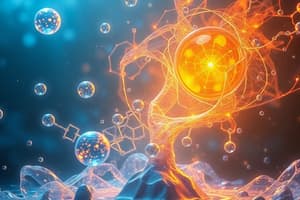Podcast
Questions and Answers
Which type of intermolecular interaction would most enhance the water solubility of a medication?
Which type of intermolecular interaction would most enhance the water solubility of a medication?
- London dispersion forces only
- Hydrogen bonds (correct)
- Covalent bonds
- Induced dipole-induced dipole
What characterizes a saturated solution?
What characterizes a saturated solution?
- It contains more solute than the solvent can accommodate.
- It contains less solute than the solvent can accommodate.
- It contains the maximum possible amount of solute that can dissolve in the solvent at a given temperature. (correct)
- It contains undissolved solute at the bottom of the container.
What happens when a solute is added to a supersaturated solution?
What happens when a solute is added to a supersaturated solution?
- The temperature of the solution increases.
- The solute dissolves, increasing the concentration.
- The excess solute will crystallize out of the solution. (correct)
- The solution becomes unsaturated.
According to the principle of 'like dissolves like', which solvent would best dissolve a nonpolar substance?
According to the principle of 'like dissolves like', which solvent would best dissolve a nonpolar substance?
How does increasing temperature generally affect the solubility of gases in liquids?
How does increasing temperature generally affect the solubility of gases in liquids?
Why do hypothermic patients retain anesthetic gases longer?
Why do hypothermic patients retain anesthetic gases longer?
Consider two liquids, A and B. If A and B are miscible, what does this imply about their solubility?
Consider two liquids, A and B. If A and B are miscible, what does this imply about their solubility?
A chemist discovers a new solvent that, unexpectedly, dissolves both polar and nonpolar substances equally well. Which of the following properties would this solvent most likely possess?
A chemist discovers a new solvent that, unexpectedly, dissolves both polar and nonpolar substances equally well. Which of the following properties would this solvent most likely possess?
What is the term for the energy change that occurs when a solute dissolves in a solvent?
What is the term for the energy change that occurs when a solute dissolves in a solvent?
In an exothermic solution process, what happens to the temperature of the solution?
In an exothermic solution process, what happens to the temperature of the solution?
For an endothermic reaction, which of the following is true regarding the heat of solution (ΔHsoln)?
For an endothermic reaction, which of the following is true regarding the heat of solution (ΔHsoln)?
What is the effect on the solubility of a solute if ΔHsoln is negative and the temperature increases?
What is the effect on the solubility of a solute if ΔHsoln is negative and the temperature increases?
Which principle states that a system at equilibrium will adjust to counteract changes in temperature, pressure, or concentration?
Which principle states that a system at equilibrium will adjust to counteract changes in temperature, pressure, or concentration?
In the context of equilibrium, what is the anticipated shift when more products are introduced in an exothermic reaction?
In the context of equilibrium, what is the anticipated shift when more products are introduced in an exothermic reaction?
What does a decrease in the equilibrium constant indicate?
What does a decrease in the equilibrium constant indicate?
If tearing the ions apart requires more energy than is released by solvation, what is the nature of ΔHsoln?
If tearing the ions apart requires more energy than is released by solvation, what is the nature of ΔHsoln?
Consider a scenario where increasing the temperature of a solution decreases the solubility of a gas. Based on Le Châtelier's principle, what can be inferred about the dissolution of the gas?
Consider a scenario where increasing the temperature of a solution decreases the solubility of a gas. Based on Le Châtelier's principle, what can be inferred about the dissolution of the gas?
A chemist dissolves a salt in water and observes that the temperature of the water decreases significantly. To increase the solubility of this salt further, the chemist should:
A chemist dissolves a salt in water and observes that the temperature of the water decreases significantly. To increase the solubility of this salt further, the chemist should:
Which intermolecular forces are responsible for the solubility of substances in water?
Which intermolecular forces are responsible for the solubility of substances in water?
Which of the following intermolecular forces primarily affect the solubility of a substance in water?
Which of the following intermolecular forces primarily affect the solubility of a substance in water?
Flashcards
Solubility
Solubility
The amount of solute that dissolves in a specific amount of solvent at a given temperature.
Saturated Solution
Saturated Solution
A solution containing the maximum amount of solute that can dissolve at a given temperature.
Supersaturated Solution
Supersaturated Solution
A solution containing more solute than it should be able to hold at a given temperature; unstable.
Miscible
Miscible
Signup and view all the flashcards
"Like Dissolves Like"
"Like Dissolves Like"
Signup and view all the flashcards
Effect of Temperature on Solubility (Solids/Liquids)
Effect of Temperature on Solubility (Solids/Liquids)
Signup and view all the flashcards
Effect of Temperature on Solubility (Gases)
Effect of Temperature on Solubility (Gases)
Signup and view all the flashcards
Hypothermia & Anesthetic Gases
Hypothermia & Anesthetic Gases
Signup and view all the flashcards
Heat of Solution (ΔHsoln)
Heat of Solution (ΔHsoln)
Signup and view all the flashcards
Exothermic Solution Process
Exothermic Solution Process
Signup and view all the flashcards
Endothermic Solution Process
Endothermic Solution Process
Signup and view all the flashcards
Lattice Energy
Lattice Energy
Signup and view all the flashcards
Heat of Solvation
Heat of Solvation
Signup and view all the flashcards
Endothermic Process
Endothermic Process
Signup and view all the flashcards
Exothermic Process
Exothermic Process
Signup and view all the flashcards
Solubility and Exothermic ΔHsoln
Solubility and Exothermic ΔHsoln
Signup and view all the flashcards
Solubility and Endothermic ΔHsoln
Solubility and Endothermic ΔHsoln
Signup and view all the flashcards
Le Châtelier’s Principle
Le Châtelier’s Principle
Signup and view all the flashcards
Study Notes
- Solubility refers to the amount of a solute that dissolves in a specific amount of solvent at a given temperature.
- Increased water solubility allows medications to be absorbed into the bloodstream more readily.
- Factors that affect solubility include intermolecular interactions, temperature, and pressure.
- Medications forming hydrogen, dipole-dipole, or ion-dipole bonds are more water-soluble than those forming covalent bonds. Alkanes and alkenes do not form hydrogen bonds with water.
- A saturated solution contains the maximum amount of solute that can dissolve.
- A supersaturated solution contains more solute than its solubility allows.
- Supersaturated solutions are unstable and the excess solute precipitates out as a solid, liquid, or gas.
- Miscible liquids are soluble in each other in all proportions.
"Like Dissolves Like"
- Solubility is enhanced when intermolecular interactions between substances have similar electron configurations.
- Polar solutes dissolve best in polar solvents, while nonpolar solutes dissolve best in nonpolar solvents.
- Salt (NaCl) dissolving in water demonstrates this principle, due to the similar polarities of water and salt's components.
- Nonpolar substances like nitrogen, carbon dioxide, and oxygen are typically insoluble in polar solvents like water.
Effect of Temperature on Solubility
- The solubility of solid and liquid solutes in liquid solvents generally increases as temperature increases.
- Gas solubility in liquids is inversely related to temperature.
- As temperature rises, less gas dissolves in a liquid because increased kinetic energy enables gas molecules to escape, preventing further dissolving.
- Lower temperatures reduce the kinetic energy of gas molecules, allowing them to dissolve into liquids.
- An example of how temperature affects solubility is the slower emergence from anesthesia in hypothermic patients receiving volatile anesthetic agents.
- Hypothermic patients retain anesthetic gases in the blood, as increased solubility is related to temperature.
Energy Changes & the Solution Process
- When a solute dissolves, there is an associated energy change that often results in a temperature change.
- The heat of solution, or enthalpy of solution (ΔHsoln), represents the energy change when dissolving one mole of solute in a solvent.
- Enthalpy (H) equals heat (Q) when pressure is constant.
- The energy change can be endothermic or exothermic.
- An exothermic process releases energy from the system (solute and solvent) to the surroundings, increasing the solution temperature.
- An endothermic process absorbs energy from the surroundings into the system, decreasing the solution temperature.
- Whether the heat of solution is endothermic or exothermic depends on the relative magnitudes of the lattice energy and the heat of solvation.
- If more energy is needed to separate ions than released by solvation, ΔHsoln is positive (endothermic).
- If more energy is released by solvation than needed to separate ions, ΔHsoln is negative (exothermic), decreasing heat.
- Breaking bonds requires energy (endothermic, cooling effect), while forming new bonds releases energy (exothermic, warming effect).
- Whether a reaction is endothermic or exothermic depends on the difference between the energy needed to break bonds and the energy released when new bonds form.
- If more heat energy is released than taken in, the reaction is exothermic; if more heat energy is taken in than released, the reaction is endothermic.
- In an endothermic reaction, an increase in temperature shifts the equilibrium towards the products.
- In an exothermic reaction, an increase in temperature shifts the equilibrium towards the reactants.
Le Châtelier’s Principle
- The solubility of a solute decreases with increasing temperature if ΔHsoln is negative (exothermic).
- The solubility of a solute increases with increasing temperature if ΔHsoln is positive (endothermic).
- A system will attempt to restore equilibrium after a change, according to Le Châtelier’s Principle.
- The position of equilibrium is influenced by changes in temperature, pressure, and concentration.
- More reactants (endothermic) favor a shift in the equilibrium to the right (products).
- More products (exothermic) will shift the equilibrium to the left (reactants).
- A decrease in the equilibrium constant indicates a shift towards the reactants.
Studying That Suits You
Use AI to generate personalized quizzes and flashcards to suit your learning preferences.
Description
Solubility is the amount of solute that dissolves in a solvent at a specific temperature. Intermolecular interactions, temperature, and pressure affect solubility. Polar solutes dissolve best in polar solvents and nonpolar solutes dissolve best in nonpolar solvents.




